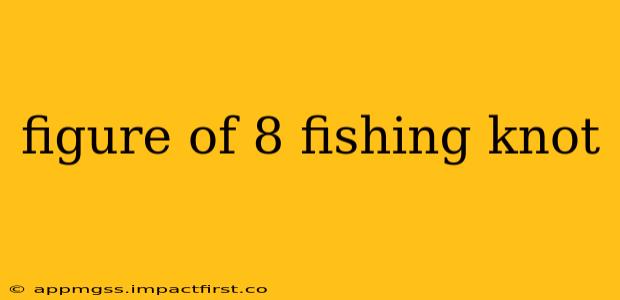The Figure 8 knot is a fundamental knot in fishing, known for its simplicity, strength, and reliability. It's a crucial knot for anglers of all skill levels, used for attaching lures, swivels, and other terminal tackle to your fishing line. This comprehensive guide will delve into the intricacies of tying this essential knot, covering everything from its applications to troubleshooting common mistakes.
What is a Figure 8 Knot Used For?
The Figure 8 knot’s primary function is to create a secure loop at the end of your fishing line. This loop can then be used to attach various fishing accessories, including:
- Fishing Lures: Securely attaching lures prevents them from detaching during the cast or fight with a fish.
- Swivels: Swivels reduce line twist, crucial for preventing line breakage and improving lure action.
- Hooks: While less common than using a clinch knot for hooks, a figure 8 loop can be used if you’re attaching a hook with a pre-formed loop.
- Leader Material: Connecting your main line to a leader material is vital for protecting your line from abrasion and improving presentation.
How to Tie a Figure 8 Knot: A Step-by-Step Guide
Tying a Figure 8 knot correctly is crucial for its effectiveness. Here's a clear, step-by-step guide:
- Start with a sufficient length of line: Leave enough extra line beyond the knot to allow for easy attachment of your lure or swivel.
- Form the initial loop: Create a loop in the line, roughly the size you need for your attachment.
- Make the figure 8: Bring the tag end (the loose end of the line) over and around the standing line (the main part of your fishing line) to form a figure 8 shape. Ensure the figure 8 is snug against the standing line.
- Pass the tag end through the loop: Carefully pass the tag end through the loop you initially created. This will secure the knot.
- Tighten the knot: Gently but firmly pull both the standing line and the tag end to tighten the knot. Be careful not to pull too hard or you risk damaging your line.
- Trim the tag end: Once the knot is secure, trim the excess tag end close to the knot, leaving just a small amount.
Why Choose a Figure 8 Knot?
The Figure 8 knot offers several advantages:
- Ease of tying: It’s relatively simple to learn and tie, even for beginners.
- Strength and security: When tied correctly, it provides a strong and reliable connection.
- Versatility: It's suitable for a wide range of line types and weights.
Troubleshooting Common Figure 8 Knot Issues
Even experienced anglers can sometimes encounter problems with the Figure 8 knot. Here are some common issues and how to avoid them:
- Loose Knot: This usually occurs from not tightening the knot sufficiently or from an incorrectly formed figure 8. Double-check your steps and ensure a firm tightening.
- Knot Slipping: This can happen with worn or damaged line. Always inspect your line before use and replace it if necessary.
- Unbalanced Knot: An uneven figure 8 can lead to weakness. Ensure the loop and the figure 8 are symmetrical.
Is the Figure 8 Knot the Strongest Knot?
While the Figure 8 knot is strong and reliable, it's not necessarily the strongest knot for all applications. Its strength is highly dependent on the correct tying technique and the quality of the fishing line. Other knots, such as the Palomar knot, often boast slightly higher breaking strength in testing. The choice of knot often depends on personal preference, experience and the specific application.
What are the Alternatives to the Figure 8 Knot?
Several other knots can serve similar purposes, offering slight variations in strength, ease of tying, or suitability for specific situations. Some popular alternatives include:
- Improved Clinch Knot: Widely considered one of the strongest knots for attaching hooks and lures.
- Palomar Knot: Another extremely strong and popular knot, particularly for lures.
- Uni Knot: A versatile knot used for attaching both lures and swivels.
The Figure 8 knot, while not the universally strongest, remains a crucial addition to any angler's repertoire due to its ease of use, reliability, and versatility for creating a secure loop. Mastering this knot will significantly improve your fishing experience.
